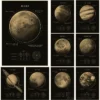The View From the Milky Way: How Earth Has Moved Since Dinosaurs Ruled
Imagine gazing skyward some 147 million years ago in the late Jurassic period as a young Stegosaurus. What stars and planets strew across the heavens visible that strange night? Even Earth’s night sky was alien, for a fascinating astronomical reason. Our world stood in a radically different orbital position while dinosaurs ruled. Tracking Earth’s solar migration through the spiral Milky Way galaxy stimulates wonder at astronomy’s echoes in deep time.
The Grand Orbit
To wrap minds around this stunning concept, first learn that our starry island home takes approximately 250 million years to travel once around the Milky Way’s central core. That places the sun and orbiting planets through ever-changing celestial scenery swirling at unimaginable speed through space.
Thankfully our stable solar orbit avoids the lethal crush of forces that would obliterate planets near the supermassive black hole heart of our galaxy. Yet even from Earth’s remote orbital arm, the stellar displays evolving outside shifting windows still baffle imagining.
Every so often, galactic movement returns our neighborhood to aligned positions after many millions of years along the vast orbital path looping the Milky Way. This cycle provokes intriguing contemplation about Earth’s extinct and future inhabitants when science glimpses astronomy’s scale through deep time lenses.
Dinosaurs Under Different Cosmic Climes
For example, consider dinosaur epochs in Earth’s history. Mighty Jurassic giants like Brachiosaurus first thundered across the planet around 213 million years ago. These and later Cretaceous-era dinosaurs like the fearsome Tyrannosaurus Rex mostly occupied our world while orbiting the Milky Way on nearly the opposite side from modern day.
The asteroid impact abruptly ending dinosaur reign 65 million years ago occurred closer to Earth’s current orbital vector. But imagine gazing at alien starfields from any lost prehistoric landscape. The entire visible galaxy swirled in a strangely shifted orientation compared with present sightlines to constellations like Orion or Ursa Minor. Sky charts for stegosauruses would require serious recalibration to match anything we now recognize on ideal stargazing nights.
Of course past orbital shifts change nothing underfoot where evolving flora and fauna tread. But grasping Earth’s stellar motion illustrates relative connections tying planetary changes to surrounding space across nearly incomprehensible timeframes. Every visible light in the air scatters from events long predating primates, an humbling scale to ponder.
Next Orbit’s Tourists: Future Humanity or Cyber Mammals?
And speculation continues regarding what far future species may walk Earth when the clockwork cosmos returns our solar system to approximate alignments 225 million years hence. Will ancestors of current biodiversity adapt to meet unimaginable changes? Or will intelligent machines shepherd new lifeforms engineered via technologies beyond conception? Either way, like Nostradamus scribing forbidden prophecies in secret code, we send intriguing riddles to distant generations awaiting the next astronomical alignment.
For now, interlacing astronomy, paleontology and astrobiology nurtures perspective on Earth’s precious position precariously suspended in spacetime. And grasping relativity of night skies dinosaurs scanned just before abrupt end stokes appreciation for each hour’s passing privilege under flickering familiar stars — until the stellar stream shifts our seasons once more through endlessly turning galactic seasons beyond tally.



